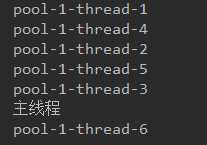标签:sleep 主线程 ssh 代码 sign turn font return submit
概览:
CountDownLatch又称闭锁,其作用是让一个或者多个线程挂起,直到其他的线程执行完后恢复挂起的线程,使其继续执行。内部维护着一个静态内部类Sync,该类继承AbstractQueuedSynchronizer(这个类之前分析过了,参见 深入分析同步工具类之AbstractQueuedSynchronizer),Sync实例维护着state属性,调用await()方法,使当前线程挂起,当一个线程执行完后,调用countDown()方法,state-1,直到state变为0,被挂起的线程恢复执行。
常用的方法:
public CountDownLatch(int count) //构造函数初始化state值,可以理解为需要优先执行的线程数量
public void await() //调用后,所在的线程挂起
public void countDown() //优先执行的线程执行完调用,state-1,当state=0,执行阻塞队列中的线程
使用实例:
主线程和线程池中的一个线程会被挂起,等线程池中的另外5个线程执行完才会被执行
CountDownLatch latch=new CountDownLatch(5); ExecutorService service= Executors.newFixedThreadPool(6); for (int i=0;i<5;i++){ service.submit(new Runnable() { @Override public void run() { try { Thread.sleep(5000); System.out.println(Thread.currentThread().getName()); } catch (InterruptedException e) { e.printStackTrace(); } latch.countDown(); } }); } service.submit(new Runnable() { @Override public void run() { try { latch.await(); System.out.println(Thread.currentThread().getName()); } catch (InterruptedException e) { e.printStackTrace(); } } }); latch.await(); System.out.println("主线程");
运行结果:

代码分析:
1.await()
//线程等待 public void await() throws InterruptedException { //AQS的实现 sync.acquireSharedInterruptibly(1); } public final void acquireSharedInterruptibly(int arg) throws InterruptedException { if (Thread.interrupted()) throw new InterruptedException(); //尝试获取状态,<0优先执行的线程未执行完,>0已执行完 //Sync子类自己实现 if (tryAcquireShared(arg) < 0) doAcquireSharedInterruptibly(arg); }
//获取AQS的state值,我们调用countDown会改变这个值 protected int tryAcquireShared(int acquires) { return (getState() == 0) ? 1 : -1; }
private void doAcquireSharedInterruptibly(int arg) throws InterruptedException { //向队列中添加一个共享节点 final Node node = addWaiter(Node.SHARED); boolean failed = true; try { for (;;) { //该节点的前驱节点 final Node p = node.predecessor(); //前驱是头节点 if (p == head) {
//获取状态值 int r = tryAcquireShared(arg); if (r >= 0) { //设置节点为头节点,退出循环 setHeadAndPropagate(node, r); p.next = null; // help GC failed = false; return; } } //否则当前线程挂起 if (shouldParkAfterFailedAcquire(p, node) && parkAndCheckInterrupt()) throw new InterruptedException(); } } finally { if (failed) cancelAcquire(node); } }
addWaiter
private Node addWaiter(Node mode) { Node node = new Node(Thread.currentThread(), mode); // Try the fast path of enq; backup to full enq on failure Node pred = tail; if (pred != null) { node.prev = pred; if (compareAndSetTail(pred, node)) { pred.next = node; return node; } } //第一个节点添加队列时,头节点和尾节点都为空,需要初始化 enq(node); return node; } private Node enq(final Node node) { for (;;) { Node t = tail; if (t == null) { // Must initialize //CAS设置头节点 if (compareAndSetHead(new Node())) //头节点赋值给tail,此时head和tail指向同一个对象,如果对任何一个对象中的属性做修改,那么2个引用的属性也会跟着变(后面挂起线程的时候会修改waitStatus属性) tail = head; } else { node.prev = t; //设置尾节点为当前结点,将2个节点串起来,即:node.prev = t;t.next = node; if (compareAndSetTail(t, node)) { t.next = node; return t;//退出循环 } } } } //注意:这里新生成的head节点并没有后继节点 head.next==null,并且head==node.prev(该node是第一次插入的节点) 这个特性在countDown的时候会使用到
当第一个节点插入队列的时候,可以用下图来描绘生成的队列:

private void setHeadAndPropagate(Node node, int propagate) { Node h = head; // Record old head for check below //设置当前结点为头节点 setHead(node); if (propagate > 0 || h == null || h.waitStatus < 0 || (h = head) == null || h.waitStatus < 0) { Node s = node.next; if (s == null || s.isShared()) doReleaseShared(); } } private void doReleaseShared() { for (;;) { Node h = head; if (h != null && h != tail) { int ws = h.waitStatus; if (ws == Node.SIGNAL) {//表明后继节点需要执行 if (!compareAndSetWaitStatus(h, Node.SIGNAL, 0)) continue; // loop to recheck cases unparkSuccessor(h); } else if (ws == 0 && !compareAndSetWaitStatus(h, 0, Node.PROPAGATE)) continue; // loop on failed CAS } if (h == head) // loop if head changed break; } } //恢复后继节点代表的线程 private void unparkSuccessor(Node node) { /* * If status is negative (i.e., possibly needing signal) try * to clear in anticipation of signalling. It is OK if this * fails or if status is changed by waiting thread. */ int ws = node.waitStatus; if (ws < 0) compareAndSetWaitStatus(node, ws, 0); /* * Thread to unpark is held in successor, which is normally * just the next node. But if cancelled or apparently null, * traverse backwards from tail to find the actual * non-cancelled successor. */ Node s = node.next; if (s == null || s.waitStatus > 0) { s = null; for (Node t = tail; t != null && t != node; t = t.prev) if (t.waitStatus <= 0) s = t; } if (s != null) LockSupport.unpark(s.thread); }
挂起线程:
//挂起线程前先将该节点的前驱节点的waitStatus设为-1,即表示其后继节点代表的线程需要执行,这样上图Node B的前驱Node A的waitStatus==-1,
因为Node A 在初始化的时候和head同引用一个对象,所以head 的waitStatus也为-1 private static boolean shouldParkAfterFailedAcquire(Node pred, Node node) { int ws = pred.waitStatus; if (ws == Node.SIGNAL) /* * This node has already set status asking a release * to signal it, so it can safely park. */ return true; if (ws > 0) { /* * Predecessor was cancelled. Skip over predecessors and * indicate retry. */ do { node.prev = pred = pred.prev; } while (pred.waitStatus > 0); pred.next = node; } else { /* * waitStatus must be 0 or PROPAGATE. Indicate that we * need a signal, but don‘t park yet. Caller will need to * retry to make sure it cannot acquire before parking. */ compareAndSetWaitStatus(pred, ws, Node.SIGNAL); } return false; } //挂起前程 private final boolean parkAndCheckInterrupt() { LockSupport.park(this); return Thread.interrupted(); }
2、countDown()
public void countDown() { //AQS中的方法 sync.releaseShared(1); } public final boolean releaseShared(int arg) { if (tryReleaseShared(arg)) {//获取状态 doReleaseShared();//恢复线程,见上面分析 return true; } return false; }
标签:sleep 主线程 ssh 代码 sign turn font return submit
原文地址:http://www.cnblogs.com/Non-Tecnology/p/6596034.html